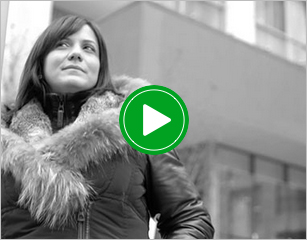Choose a savings plan to explore:
Saving for a vacation
 When you’re
working hard, a well-deserved vacation can refresh
When you’re
working hard, a well-deserved vacation can refresh
and energize you. Just planning a vacation is proven to
boost your overall happiness.1
Before you start putting money away for your next trip, it’s
wise
to explore your options and see just what type
of vacation suits
you best. Is it a week at an
all-inclusive resort, a month-long
self-guided trip
through Europe, or a cruise through the
Mediterranean?
Canadians taking time off during the winter will generally
spend about $2,600.2
Here are our suggestions to help save for a vacation
Start Saving Today
To start saving for your vacation, we suggest a
TD Every Day
Savings Account
with a
Pre-authorized
Transfer
Service
(PTS). A PTS can easily be set up so that you are
automatically transferring the money
for your
vacation from your chequing account to your savings account
on a regular basis.
Another great way to put money aside for a vacation is the
Simply Save
program. With Simply Save,
every transaction you
make with your TD Access Card you are also making a
contribution to your
savings. You can choose to
contribute $0.05 - $5 from your chequing to your TD Every
Day Savings
Account each time you make a purchase,
and watch those smaller contributions add up to a great
vacation.

Saving Tips
- Every time you get a deal, like a 2-for-1 or use
a coupon, put that money you would have
spent right into your savings. - Use cash. Put your weekly entertainment budget in
cash so you can easily see how much
your spending and how much you have left. If it’s getting low, you might decide to skip that
afternoon treat.
In addition to your budgeted savings, there are lots of
small things you can do that could really
add up and
help you reach your goal sooner. Take a look at some easy
savings tips:
Here's a summary of the products, tools and
services
that may help you with your savings goals
Starting your savings




Visit a branch today to speak with an
advisor and build
your customized savings plan
1Source: http://well.blogs.nytimes.com/2010/02/18/how-vacations-affect-your-happiness/?_php=true&_type=blogs&_r=0
2Source: http://www.newswire.ca/en/story/1125215/cibc-poll-canadians-spending-an-average-of-about-2600-on-their-march-vacations-this-year
Saving for a wedding
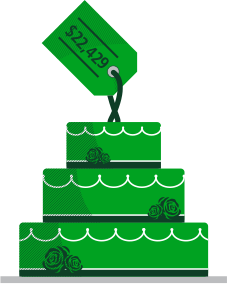 Congratulations!
Getting engaged and planning a wedding are
Congratulations!
Getting engaged and planning a wedding are
joyful times in
one’s life. A wedding is a wonderful opportunity to
celebrate an exciting step in your life, and host an event
with
family and friends that you won’t ever forget.
You may have been dreaming of this day for years, or are
just
beginning to plan. Either way, it’s easy for
wedding costs to really
add up.The average expected
cost of a wedding in Canada
excluding the honeymoon
is $22,429.1 So, it’s important to sit
down with your future spouse or family and talk about what
is
really important for you both to have at your
wedding and what’s
flexible. Once you know these
details, you can begin saving for
your special day.
Here are our suggestions to help you save for a wedding
Start Saving Today
Opening a TD High Interest Savings Account(HISA) will give you a place to put away the money you’re saving for your wedding, along with any monetary help you’ve received from family or friends.

Once you’ve got your savings account open, setting up a
monthly Pre-authorized
Transfer
Service
is an easy way to make sure the money you’ve allocated
for the wedding gets from
your chequing account to your
HISA on a regular basis.
 40% of couples
are engaged for 13-18 months before tying the knot,which is
a nice amount of time to
40% of couples
are engaged for 13-18 months before tying the knot,which is
a nice amount of time to
build your wedding savings.2

Saving Tips
- Set up a short-term savings goal. Saving just $20 a week can add up to over $1,000 a year.
- Save all your change. At the end of each day,
take all the change from your wallet and place
it in a ‘wedding fund’ jar. Just $2 a day from each of you can add up to over $1,000 in a year.
Put your savings to work for you
Once you’ve had time to accumulate some savings for your wedding, you can start to invest it and earn more money.
Talk to a Financial Advisor about investing your savings
into a Guaranteed
Investment Certificate
(GICs) or Term
Deposits that have a maturity date that align with your
wedding planning.
-25.jpg)
GICs and Term Deposits provide a safe way to save because
your initial investment is
protected. Many GICs and Term
Deposits have flexible terms that range from 30 days to
five
years, so depending on when you’re having your
wedding, this could be a good option for
growing your
savings.
Here's a summary of the products, tools and
services
that may help you with your savings goals
Starting your savings



Putting your savings to work

Visit a branch today to speak with an
advisor and build
your customized savings plan
1Source: http://business.financialpost.com/2013/01/26/affordable-wedding-planning-tips/
2Source: http://www.huffingtonpost.com/2013/01/04/average-engagement-length_n_2411353.html
Saving for a home or condo down payment

Taking the step
to buy a home of your own is a very exciting and
rewarding experience. A good place to get started is
considering your options: condo or house? The
neighbourhood? Fixer-upper or new construction?
Once you’ve got a feel for the cost implications of
these decisions, then you can roughly determine
what you’re looking at spending.
The national average home price is climbing and currently sits just over $400,000.1
The cost of a home may seem overwhelming, and saving for a down payment can be daunting if you are just starting out. But, with the proper planning, budgeting and saving you can be well on your way to owning your own home.
Here are our suggestions to help you
save
for a down payment
Start Saving Today
Open a TD
High Interest Savings Account or a Tax-Free
Savings Account to start putting the money away
for your down payment. Moving your down payment savings out
of your everyday banking account and
into one of
these accounts will help you set your funds aside and build
your savings.

Make it easier to save by setting up a Pre-authorized
Transfer Service. This service can be set
on a
weekly, bi-weekly or monthly basis and will automatically
move the funds you’ve
budgeted for your down
payment from your everyday bank account into your savings
account.

Consider using your Retirement
Savings Plan (RSP) to help with your down payment. For
first
time home buyers, the Home
Buyer’s Plan lets you withdraw up to $25,000 from your
RSP (up to $50,000 for a couple) to help with your down
payment2.

Saving Tips
In addition to your budgeted savings, there are lots of
small things you can do that could really
add up
and help you reach your goal sooner. Take a look at some
easy savings tips:
- Save your change! If you put your spare change
aside at the end of every day, it can really
add up. That $1.00 of change a day saves you $365.00 a year. - Take your lunch at least twice a week. If you’re
saving $10 each time you bring your lunch,
that could add up to close to $1,000 in savings a year. - Borrow instead of buy. Your neighbourhood library
has tons of books and DVDs to choose
from, so instead of buying a new book or DVD each month – sign them out for free. That
could add up to around $240 of savings a year.3
Put your savings to work for you
Once you’ve had the time to build up some savings for your
down payment, you can start to invest it and
earn
more money.
Talk to a Financial Advisor about investing your savings
into a Guaranteed
Investment Certificate (GICs)
or
Mutual Funds4.
-25.jpg)
GICs
and Term Deposits provide a safe way to save because your
initial investment is
protected. Many GICs and
Term Deposits also guarantee a rate of return for the term
of your
investment, which can help you plan when
and how you’ll use that money.
Investing in mutual
funds means you’re putting your money into a portfolio of
bonds, stocks,
and/or money market investments –
all selected and managed by a professional. Investing in a
number of different assets through a mutual fund, can
lower your risk because your money is
not
dependent on the performance of a single investment.

Setting up a Pre-authorized
Purchase Plan automatically invests your money in TD
Mutual
Funds at regular intervals. It ensures
that you’re paying yourself first.
Here's a summary of the products, tools and
services
that may help you with your savings goals
Creating a budget


Starting your savings




Visit a branch today to speak with an
advisor and build
your customized savings plan
1Source: http://www.cbc.ca/news2/interactives/housing-canada/
2Conditions and eligibility requirements apply.
3Source: http://www.tdgetsaving.com/#/savings-tips
4Mutual Funds Representatives with TD Investment
Services Inc. distribute mutual funds at TD Canada Trust.
Saving for a child's education
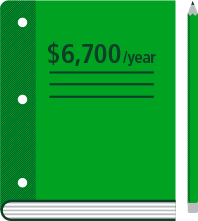
A post-secondary education is an important step to ones’ success, and helping a child realize that goal is a great achievement.
But the cost of higher education is rising, and tuition alone can be quite expensive. The average university tuition in Canada is approximately $5,7001 a year and that doesn’t include books or living expenses.
With the right planning, you can make saving a part of your routine and help your education savings grow.
Here are our suggestions to help save
for a
child’s university or college education
Start Saving Today
Start by opening a Registered Education Savings Plan(RESP) for a child. An RESP is an account registered with the Government of Canada to help you save for a child’s post-secondary education. When you contribute to an RESP, you become eligible for government grants that can amount to thousands of dollars for a child’s future education.

The government gives you a basic grant of 20% on the first $2,500 of annual contributions to an RESP. That's up to $500 per beneficiary each year to a lifetime limit of $7,200 towards a child's education.
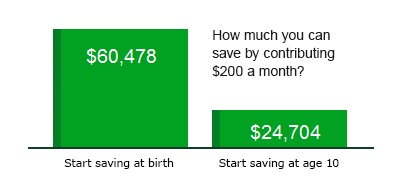
This chart assumes a 2% rate of return (moderate risk portfolio) compounded annually until the child is 18 years old. Savings include your contributions, government contributions, and investment income. Calculations assume basic Canada Education Savings Grant (CESG) contribution of 20% annually. Additional CESG grants may be available depending on your income.
For Illustrative Purposes Only
Build education savings for your child
using the Universal Child Care Benefit
The enhanced UCCB can be a great way to start saving for a child’s education.

The federal government through the Universal Child Care Benefit provides monthly payments to families of $160 per child between 0-5, and $60 per child between 6-17. That’s a total of up to $20,160 per child in lifetime benefits.
With an Education Savings Plan, you're eligible to receive the Canada Education Savings Grant (CESG), which matches 20% of annual contributions up to a maximum of $500 per year and $7,200 lifetime limit, per child. That means you could receive up to $4,0322 in CESG benefits per child when you contribute your full UCCB payments from age 0 to 17 amounting to $20,160 to an RESP.3

So start or increase your education savings by putting your UCCB into a RESP at TD.
Want to know how much you could save for a child in an RESP?
Here's a summary of the products, tools and
services
that may help you with your savings goals
Starting your savings




Visit a branch today to speak with an
advisor and build
your customized savings plan
1 Source: Statistics Canada, Centre for Education Statistics.
2 $4,032 is calculated on the assumption that the RESP is eligible for the Canada Education Savings Grant (CESG). The CESG will top up annual RESP contributions by 20% on the first $2,500 in contributions (up to $500 per child each year, to a lifetime limit of $7,200, per child).
3 $50,000 per child is the lifetime contribution limit.
Saving for retirement
 We all look forward to the day
we can retire, kick back and enjoy
We all look forward to the day
we can retire, kick back and enjoy
some much deserved free
time. While that day might seem far
off, the sooner
you start saving the more you’ll have to work with
later on.
According to Statistics Canada, the average Canadian retires
by
the age of 63.1 That means the
average retirement in Canada
now lasts for
approximately 20 years.
So how do you start planning? Start with what your ideal
retirement looks like – how do you want to spend your time?
Do
you imagine your lifestyle will change
drastically, or not all? Once
you have an idea of
how you’d like to spend your retirement, our
Retirement Savings Calculator
can help you start planning for how
much you’ll need to save to do it comfortably.
Here are our suggestions to help you save for retirement
Start Saving Today
It's important to begin saving for the long-term so you can
retire comfortably and live the lifestyle you
want. A Retirement
Savings Plan (RSP) or a Tax-Free
Savings Account(TFSA) are great ways to start
saving for
the future RSPs reduce your taxable income, and growth
earned is non-taxable as long as it
remains in the
RSP, helping you build a larger retirement fund for the
future. A Tax-Free Savings Account (TFSA) is another great
option to help save towards your retirement goal, because
your savings grow
tax-free. You don't pay taxes on
the investment income or growth earned in your TFSA, even
upon
withdrawal, - helping you build your savings
faster.

Consider setting up an Automated
Savings Plan. Automatically transferring funds from your
everyday chequing account into your RSP or TFSA account
provides a disciplined approach to
saving. With this
savings method, you’ll never have to worry or wonder about
missing a
contribution and your savings can grow without
you even thinking about it.

Saving Tips
There are lots of small things that can help your savings add up:
- Take advantage of an employees savings programs
in which your employer matches or
supplements what you’re contributing. - Put any bonuses you receive right into your
savings. Set aside a small amount
to treat yourself, but put the majority of that bonus away.
Put your savings to work for you
TD offers investment options to help you achieve your goals
no matter how big or small. With a wide
range of investment
options for RSPs and TFSAs to choose from, you’re sure to
find the right investment
to help you with your retirement
and savings goals.
-25.jpg)
Guaranteed
Investment Certificates and Term
Deposits are a good investment choice if you
want to give
your money a chance to grow, safe and secure.
Mutual
Funds will give you access to a broad range of
professionally managed investments,
from bonds to stocks
and other investable assets. These investments are
carefully selected and diversified in order to help
minimize risk.
Talk to a Financial Advisor2 about the investment option that is right for you.
Here's a summary of the products, tools and
services
that may help you with your savings goals
Creating a budget


Starting your savings




Visit a branch today to speak with an
advisor and build
your customized savings plan
1Source: http://www5.statcan.gc.ca/cansim/pick-choisir?lang=eng&p2=33&id=2820051
2Mutual Funds Representatives with TD Investment
Services Inc. distribute mutual funds at TD Canada Trust.
Starting your savings
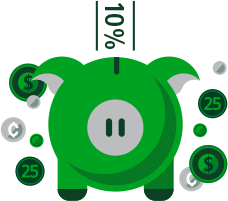
Building savings is not only beneficial for things you may want to do in the future, like buy a home or take a nice vacation, but also provides a layer of security in times of uncertainty.
Half of Canadians are putting less than 5% of their pay cheque towards savings.1
A general guideline is to put at least 10% of your income towards your savings. Even if you’re currently paying off student loans or other debt, it’s essential to ensure you pay yourself too. Then over time as you make more, you can increase the amount you save as well.
Here are our suggestions to help save for the future
Start Saving Today
Open a TD
High Interest Savings Account or a Tax-Free
Savings Account to begin saving towards your
goal. Make it easier to save by setting up an automatic
savings plan called Pre-authorized
Transfer
Service
(PTS). A PTS will automatically move funds from your
everyday bank account into your savings
account.
This is a great way to grow your savings without you even
having to think about it.

Another great way to put money aside is the Simply Save program. With Simply Save, every transaction you make with your TD Access Card you are also making a contribution to your savings. You can choose to contribute $0.05 - $5 from your chequing to your TD Every Day Savings Account.

Saving Tips
There are lots of small things you can do that could
really add up and help you reach your goal
sooner. Take a look at some easy savings tips:
- Write a shopping list and stick to it to help prevent those impulse buys from adding up.
- While you’re at it, buy generic. Many pantry
basics are just as good, if not better, than the
brand name items you pay more for. - Switch one night out a week to a night in.
Instead of meeting friends for dinner, have a get
together at your place.
Put your savings to work for you
Once you've had the time to build up some savings, you can start to invest it and earn more money.
-25.jpg)
Guaranteed Investment Certificates (GICs) and Term Deposits provide a safe way to save because your initial investment is protected. Many GICs and Term Deposits also guarantee a rate of return for the term of your investment, which can help you plan when and how you’ll use that money.
Mutual Funds provide easy access to the growth potential offered by stocks and bonds without you needing to be an expert. Professionals will select and manage the investments held in the mutual fund to seek to maximize growth, as well as help you plan when and how you can use your savings.
Talk to a Financial Advisor2 about investing
your savings into
Guaranteed Investment Certificate (GICs) or Term
Deposits and Mutual
Funds.
Important
Mutual Fund Information
Here's a summary of the products, tools and
services
that may help you with your savings goals
Starting your savings




Putting your savings to work


Visit a branch today to speak with an
advisor and build
your customized savings plan
1Source: http://well.blogs.nytimes.com/2010/02/18/how-vacations-affect-your-happiness/?_php=true&_type=blogs&_r=0
2Mutual Funds Representatives with TD Investment
Services Inc. distribute mutual funds at TD Canada Trust.
Plans & Products
Registered Plans
There's choice when it comes time to invest for your future goals. With our helpful advice, you'll find the plans that are right for you.
Savings & Investment Products
Grow your savings with our innovative investment products. We'll help you understand your options, and provide sound advice.
Ways to Save
Setting up an automatic savings and contribution plan makes saving for your future goals just one of life's routines.
Tools
Retirement Savings Calculator
Find out where you stand
today and how much you'll
need to save to reach your
retirement goals.
TFSA Savings Calculator
Want to know how much you
could save in taxes by putting
money in a Tax-Free Savings Account?
Education Savings Calculator
Find out how much you need
to save today, to meet your
education cost tomorrow.
TD Get Saving
Tools designed to help
you "get" the world of savings.








